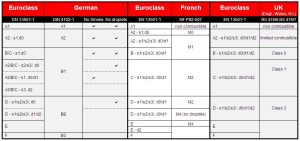Fire protection refers to all measures that prevent the occurrence and spread of fire = fire and smoke (preventive fire protection or fire prevention) and make it possible to save people and animals and to carry out effective extinguishing work in the event of fire (defensive fire protection).
In Europe, there are different national standards required by the legislator.
The transition from national to European standards and approvals began with the adoption of the European Construction Products Directive, which has since been transformed into the Construction Products Regulation (CPR).
The new European standard is intended to replace the many national standards of the Member States. Only time will tell whether the standard will gain universal recognition.
In this PDF you will find a comparison of the different fire safety standards in Europe.
Here you will find brief Explanations of fire protections terms in Germany and Europe , such as building material class/ building product class/ fire class/ fire behaviour/ fire resistance class.
Here you will find an overview of the most common testing standards worldwide. (Only available in German). However, these are difficult to compare, as the test methods differ greatly from country to country.
Are you interested in these facts? Here you will find the overview Fire protection knowledge compact.
These regulations apply to ALL public buildings, i.e. ALL areas frequented by the public. These safety regulations serve to protect the people who are in the buildings. They minimise the risk of a fire developing and spreading. And in an emergency, when there is a fire, the time to flee is extended.

Fire protection must therefore be adhered to in the following buildings:
- in public buildings
- in theatres, operas and cinemas, museums, etc.
- in schools, universities, technical colleges or training centres
- in hotels and restaurants, clubs and casinos
- in office buildings, public libraries and facilities (kindergartens, nursing homes)
- in trade fair halls and exhibition halls
- in event tents
Not only building materials should be considered, but also decorative materials and furniture.
Decorative materials also include wall coverings, room dividers, displays, banners, flags and the like.
Everyone is obliged to act responsibly so that no fire develops. All these materials must be at least flame-retardant in accordance with DIN 4102 or DIN EN 13501-1.
The same high requirements for fire protection apply to passenger transport in local and long-distance transport by bus, and even higher requirements for fire protection exist in the areas of aviation, shipping and rail transport.

